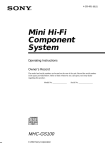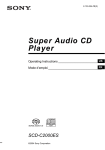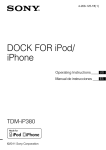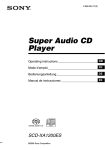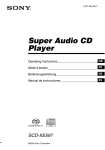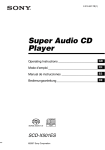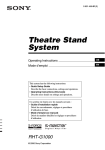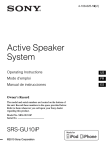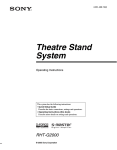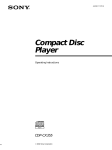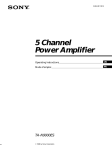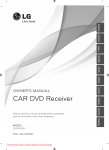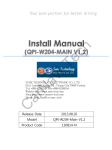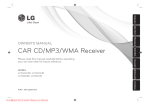Download Super Audio CD Player
Transcript
2-103-393-13(1) Super Audio CD Player Operating Instructions SCD-CE595 ©2004 Sony Corporation WARNING WARNING To prevent fire or shock hazard, do not expose the unit to rain or moisture. To avoid electrical shock, do not open the cabinet. Refer servicing to qualified personnel only. To prevent fire, do not cover the ventilation of the apparatus with news papers, table-cloths, curtains, etc. And don’t place lighted candles on the apparatus. To prevent fire or shock hazard, do not place objects filled with liquids, such as vases, on the apparatus. Don’t throw away the battery with general house waste, dispose of it correctly as chemical waste. NOTICE FOR THE CUSTOMERS IN THE U.S.A. This equipment has been tested and found to comply with the limits for a Class B digital device, pursuant to Part 15 of the FCC Rules. These limits are designed to provide reasonable protection against harmful interference in a residential installation. This equipment generates, uses, and can radiate radio frequency energy and, if not installed and used in accordance with the instructions, may cause harmful interference to radio communications. However, there is no guarantee that interference will not occur in a particular installation. If this equipment does cause harmful interference to radio or television reception, which can be determined by turning the equipment off and on, the user is encouraged to try to correct the interference by one or more of the following measures: – Reorient or relocate the receiving antenna. – Increase the separation between the equipment and receiver. – Connect the equipment into an outlet on a circuit different from that to which the receiver is connected. – Consult the dealer or an experienced radio/TV technician for help. CAUTION You are cautioned that any changes or modifications not expressly approved in this manual could void your authority to operate this equipment. Owner’s Record This symbol is intended to alert the user to the presence of uninsulated “dangerous voltage” within the product’s enclosure that may be of sufficient magnitude to constitute a risk of electric shock to persons. This symbol is intended to alert the user to the presence of important operating and maintenance (servicing) instructions in the literature accompanying the appliance. The model and serial numbers are located at the rear. Record the serial number in the space provided below. Refer to them whenever you call upon your Sony dealer regarding this product. Model No. ______________ Serial No. ______________ NOTICE FOR THE CUSTOMERS IN CANADA This Class B digital apparatus complies with Canadian ICES-003. CAUTION CAUTION The use of optical instruments with this product will increase eye hazard. The use of optical instruments with this product will increase eye hazard. CAUTION TO PREVENT ELECTRIC SHOCK, MATCH WIDE BLADE OF PLUG TO WIDE SLOT, FULLY INSERT. 2US Table of Contents Features of the player ....................................................................................4 Compatible Disc Types .................................................................................4 About the Super Audio CD ...........................................................................5 Getting Started Inserting batteries into the remote .................................................................6 Hooking Up the Audio Components .............................................................6 Playing Discs Playing a Disc................................................................................................9 Using the Display ........................................................................................10 Replacing Discs While Playing a Disc........................................................12 — Ex-Change Locating a Particular Point in a Track.........................................................13 Playing Tracks Repeatedly ..........................................................................13 — Repeat Play Playing Tracks in Random Order ................................................................14 — Shuffle Play Creating Your Own Program ......................................................................14 — Program Play Enjoying a Multi-channel Super Audio CD ................................................15 — Multi-channel management function Additional Information Precautions ..................................................................................................20 Notes on Discs.............................................................................................21 Troubleshooting...........................................................................................21 Specifications ..............................................................................................22 Index to Parts and Controls .........................................................................23 3US Features of the player This player is designed to play back 2-channel and Multi-channel Super Audio CDs, and conventional CDs, and provides the following features: • Mounted with a Discrete Dual Laser Optical Pickup, capable of reading a Super Audio CD or conventional CD depending on the exclusive wavelength. • Quicker track access performance enabled by an advanced servo mechanism. • A Multi-Channel Management function that allows you to adjust the multi-channel playback environment according to the allocation and size of your speakers. • A Super Audio D/A Converter, which allows higher-quality sound reproduction. • A Super Audio CD can mark up to 255 track numbers. This feature applies to SCD-CE595. • The supplied remote is capable of controlling both the SCD-CE595 and a conventional Sony CD player. Compatible Disc Types You can play the following types of discs on this player. • Super Audio CDs • Audio CDs This player cannot play the following discs. If you try to play them, the error message “TOC ERROR” or “NO DISC” will appear. • CD-ROMs • DVDs, etc. Music discs encoded with copyright protection technologies This product is designed to playback discs that conform to the Compact Disc (CD) standard. Recently, various music discs encoded with copyright protection technologies are marketed by some record companies. Please be aware that among those discs, there are some that do not conform to the CD standard and may not be playable by this product. Notes on CD-R/CD-RW playback Discs recorded on CD-R/CD-RW drives may not be played back because of scratches, dirt, recording condition, or the drive’s characteristics. Besides, the discs, which are not yet finalized at the end of recording, cannot be played back. In these cases, “READING” will remain or “TOC ERROR” will appear in the display. Note on dts-CDs Do not play a dts-CD on this player. If you do, severe noise will be generated. 4US About the Super Audio CD Super Audio CD is a new high-quality audio disc standard where music is recorded in the DSD (Direct Stream Digital) format (conventional CDs are recorded in the PCM format). The DSD format, using a sampling frequency 64 times higher than that of a conventional CD, and with 1-bit quantization, achieves both a wide frequency range and a wide dynamic range across the audible frequency range, and so provides music reproduction extremely faithful to the original sound. An SA-CD layer consists of the 2 channel area or the multi-channel area. 2 channel area: An area in which 2 channel stereo tracks are recorded Multi-channel area: An area in which multichannel (up to 5.1 channels) tracks are recorded Example: When the 2 channel area and the multi-channel area are recorded on an SA-CD layer of a hybrid disc 2 channel area4) Types of Super Audio CDs There are two types of discs, depending on the SA-CD layer and CD layer combination. SA-CD layer: A high-density signal layer for Super Audio CD CD layer1): A layer that is readable by a conventional CD player Single layer disc (a disc with a single SA-CD layer) Multi-channel area4) 1) 2) 3) SA-CD layer 4) Hybrid disc2) (a disc with an SA-CD layer and a CD layer) SA-CD layer You can play the CD layer on a conventional CD player. Since both layers are on one side, it is not necessary to turn the disc over. Press SA-CD/CD to select the layer you want to listen to (see page 9). In case of a disc with both areas, press MULTI/2CH to select the area you want to listen to (see page 10). CD layer3) SA-CD layer3) 5US Getting Started Inserting batteries into the remote Insert two R6 (size-AA) batteries into the battery compartment with the + and – correctly oriented to the markings. When using the remote, point it at the remote sensor on the player. Tip Under normal conditions, the batteries should last for about six months. When the remote no longer operates the player, replace both batteries with new ones. Notes • Do not leave the remote in an extremely hot or a humid place. • Do not drop any foreign object into the remote casing, particularly when replacing the batteries. • Do not use a new battery with an old one. • Do not expose the remote sensor to direct sunlight or lighting apparatus. Doing so may cause a malfunction. • If you do not intend to use the remote for an extended period of time, remove the batteries to avoid possible damage from battery leakage and corrosion. Hooking Up the Audio Components Connect the Super Audio CD player to an audio component. Be sure to turn off the power of all components before making connections and connect securely to prevent noise. Connecting a multi-channel amplifier When you have an amplifier equipped with the 5.1CH input jacks (multi-channel amplifier, AV amplifier, etc.) and connect the player and the amplifier through the ANALOG 5.1CH OUT jacks (FRONT L/R, SURR L/R, CENTER, SUB WOOFER), you can play a Multi-channel Super Audio CD and enjoy the multi-channel playback. Use audio connecting cords for this connection. For FRONT or SURR connection, use the connecting cords (Red and White jacks) and be sure to match the color-coded pin to the appropriate jacks: white (left) to white and red (right) to red. For CENTER and SUB WOOFER connection, use the connecting cords (Black). FRONT or SURR connection Audio connecting cords (one cord is supplied) White (L) Red (R) CENTER or SUB WOOFER connection Audio connecting cords (not supplied) Black 6US Connecting a stereo amplifier or MD deck Getting Started When you connect a stereo amplifier or make an analog connection with an MD deck, connect the player and the component through the ANALOG 5.1CH OUT FRONT L/R jacks. Use an audio connecting cord for this connection. Be sure to match the color-coded pin to the appropriate jacks: white (left) to white and red (right) to red. Audio connecting cord (supplied) To multi-channel amplifier, AV amplifier, etc. A A: B: C: D: B White (L) Red (R) CD To front speaker input jacks (L/R) To surround or rear speaker input jacks (L/R) To sub woofer input jack To center speaker input jack Note There are 5CH, 4CH, and 3CH Super Audio CD. When you play these discs, the signal does not output from all the jacks of the ANALOG 5.1CH OUT. For details of the playback, see the cover or instructions of the Super Audio CD. To CD (Super Audio CD) or line input jacks (L/R) on a stereo amplifier, MD deck, etc. Note When a disc with the 2 channel area and multi-channel area is played through the ANALOG 5.1CH OUT FRONT L/R jacks, change the default playback area to “SEL– 2ch” (2 channel playback area) (see page 10). If you do not, the multi-channel playback area will be automatically played back and only the signal to the front speakers will be output. In this case, the vocals or other sounds may not be heard, depending on the disc. continued 7US Connecting a digital component When you connect an MD deck or another digital component through the DIGITAL (CD) OPTICAL OUT connector, you can make a digital recording. Use an optical digital cable for this connection. When connecting the optical digital cable to the DIGITAL (CD) OPTICAL OUT connector, push the cable plug in until it clicks into place. Be careful not to bend or twist the optical cable. Optical digital cable (not supplied) When using another Sony CD player in conjunction with this player You can set the supplied remote to be effective on this player only by changing the command mode of the remote. To set the command mode of the remote • If the other player’s command mode can be set: Set the CD1/2 switch of this player’s remote to CD1 (factory setting), and set the other player’s remote to CD2. • If the other player’s command mode cannot be set: Set the CD1/2 switch of this player’s remote to CD2. To set the command mode of this player 1 2 3 To CD optical digital input connector on an MD deck, etc. Note Only the audio signals of conventional CDs can be output from the DIGITAL (CD) OPTICAL OUT connector. Those of the Super Audio CD cannot be output through the DIGITAL (CD) OPTICAL OUT connector. Connecting the AC power cord Connect the AC power cord to a wall outlet. 8US Press MENU on the player. Turn l AMS L (or press ./> on the remote repeatedly) to select “CD1/2 SEL”. Press l AMS L (or ENTER on the remote). The current command mode appears. 4 Turn l AMS L (or press ./> on the remote) to select “CD – 1” or “CD – 2”, then press l AMS L (or ENTER on the remote). 7 Playing a Disc 1 2 3 4 Turn on the amplifier. Turn down the volume level to the lowest. 8 Adjust the volume on the amplifier. Basic operations during play To Do the following: Select the player position using the input selector on the amplifier. Stop play Press x. Pause play Press X. Press POWER on the player to turn on the player. Resume play after pausing Press X or H. Select a track Turn l AMS L (or press ./> on the remote repeatedly). Select a disc Press DISC SKIP (or DISC SKIP +/– on the remote) repeatedly. By pressing DISC 1-5 on the player, you can select a specific disc directly. Eject a disc Press A OPEN/CLOSE on the player. Press A OPEN/CLOSE on the player to open the disc tray, and place a disc on the tray. Playing Discs Playback starts from the first track. If you want to start playing from a specific track, turn l AMS L (or press ./> on the remote repeatedly) to select the track number before pressing H. Playing Discs The operations for normal play and the basic operations during play are explained below. Press H. Note With the label side up 5 Disc number To place other discs, press DISC SKIP (or DISC SKIP +/– on the remote) repeatedly and place the discs in the order you want to play. Each time you press the button, the disc tray turns and you can place the discs in the empty disc compartments. The player plays the disc in front of you first. 6 Press PLAY MODE (or CONTINUE on the remote) repeatedly to select ALL DISCS or 1DISC Continuous Play mode. Each time you press CONTINUE on the remote, “ALL DISCS” or “1 DISC” appears in the display. When you select The player plays ALL DISCS All discs in the player consecutively in the order of disc number 1DISC Only the disc you have selected During playback, increase the volume level gradually starting from the lowest level. The output from this player may contain band width that is out of the normal listening range. This may cause damage to the speakers or ears. Selecting the playback layer When playing a hybrid disc with an SA-CD layer and a CD layer (page 5), you can select the layer you want to listen to. Also, since both layers are on one side, it is not necessary to turn the disc over. Press SA-CD/CD to select the desired playback layer. To select the default playback layer 1 2 Press MENU on the player. Turn l AMS L (or press ./> on the remote repeatedly) until “LAYER SEL” appears in the display. continued 9US 3 Press l AMS L (or ENTER on the remote). Using the Display The current default layer appears. 4 5 Turn l AMS L (or press ./> on the remote) to select the desired playback layer. The display window shows various information about the disc or track being played. This section describes the current disc information and information that appears for each play status. Press l AMS L (or ENTER on the remote). Selecting the playback area When playing a disc with the 2 channel playback area and the multi-channel playback area (page 5), you can select the playback area you want to listen to. Disc information when a disc is loaded The display shows the current disc number, total number of tracks and total playing time. A B C Press MULTI/2CH to select the desired playback area. To select the default playback area 1 2 3 Press MENU on the player. Turn l AMS L (or press ./> on the remote repeatedly) until “M/2ch SEL” appears in the display. Press l AMS L (or ENTER on the remote). The current default area appears. 4 5 Turn l AMS L (or press ./> on the remote) to select the desired playback area. Press l AMS L (or ENTER on the remote). Note The multi-channel playback area is automatically selected whenever you start playback because “SEL– Mch” (multi-channel playback area) is the factory setting. Select “SEL– 2ch” (2 channel playback area) when only the ANALOG 5.1CH OUT FRONT L/R jacks are connected. 10US F E D A: Total number of tracks B: Hybrid disc C: Currently selected disc and number of playable channels D: Track 16 and above (for discs with 16 or more tracks) E: Total playing time F: Current disc number Notes on the disc number indications • The red circle around a disc number indicates the disc is ready to be played. • A semi-circle around the disc number indicates a disc with tracks to be played. In Program Play mode, the semi-circle indicates a disc with programed tracks. • The disc number disappears when no disc is detected in the disc component. Displaying the information Before you start playing Press TIME/TEXT repeatedly. Each time you press the button, the disc name or artist name appears in the display. When you select the artist name, “ART.” appears in the display. Press TIME/TEXT repeatedly. When the player detects a Multi-channel Super Audio CD, the channel information appears for a few seconds after the track title appears. Playing Discs TEXT discs contain information, such as the disc name or artist name, as well as the audio signals. This player can display the disc name, artist name, and current track name as TEXT information. When the player detects a TEXT disc, “TEXT” appears in the display. If your TEXT disc has several languages, “MULTI-TEXT” appears in the display. When you want to check the information in another language, see “Displaying the information of a TEXT disc in other languages” on page 12. If a name has 13 or more characters, the first 12 characters will remain after the name scrolls by in the display. While playing a disc Playing time of the current track Remaining time of the current track Remaining time of the disc1) Track title2) Disc title* Artist name* Channel information (appears only when the player detects a Multi-channel Super Audio CD) 1) 2) Total number of tracks and total playing time Only when Continuous Play is selected Only for TEXT discs Notes * Only for TEXT discs • The display may not show all the characters, depending on the disc. • This player can display only the disc name, artist name, and track names from TEXT discs. Other information cannot be displayed. continued 11US Turning off the information in the display Press DISPLAY MODE on the remote. Each time you press the button while playing a disc, the display turns off and on alternately. Even when the display is turned off, it will turn on when certain buttons are pressed, and then turn off again after a few seconds. Before you start playing, when you press the button to turn off the display, “DISP OFF” appears, and when you press the button to turn on the display, “DISP ON” appears. — Ex-Change Displaying the information of a TEXT disc in other languages 2 You can open the disc tray while playing a disc so that you can check what discs are to be played next and replace discs without interrupting play of the current disc. 1 1 2 4 Turn l AMS L (or press ./> on the remote repeatedly) until “LANGUAGE” appears in the display. Press l AMS L (or ENTER on the remote). The current selected language (ENGLISH, FRENCH, GERMAN, etc.) flashes. If the player cannot display the language used in a TEXT disc, “OTHER LANG” appears in the display. 4 5 Turn l AMS L (or press ./> on the remote repeatedly) until the desired language appears in the display. Press l AMS L (or ENTER on the remote). After a few seconds, the information appears in the selected language. Replace discs in the compartments with new ones. The player plays the disc on the left side compartment after the current disc, and then the one on the right side compartment. 3 Press MENU on the player. Press EX-CHANGE on the player. The disc tray opens and two disc compartments appear. Even if the player is playing a disc, it does not stop playing. You can change the displayed language if the TEXT disc has multi language capacity. When the player detects such a TEXT disc, “MULTITEXT” appears in the display. Change the language according to the procedures below. 3 12US Replacing Discs While Playing a Disc Press DISC SKIP (or DISC SKIP +/– on the remote). The disc tray turns and other two disc compartments appear. 5 Replace discs in the compartments with new ones. Press EX-CHANGE on the player. The disc tray closes. Note Do not push the disc tray to close it in Step 5, as you may damage the player. While the disc tray is open by pressing EXCHANGE on the player • If the play of the current disc ends, the player stops playing. If the disc is played in 1DISC Repeat Play mode (page 13), the current disc starts playing again. • In ALL DISCS Shuffle Play mode (page 14), tracks are reshuffled on the current disc. • In Program Play mode (page 14), only the tracks on the current disc are played. Locating a Particular Point in a Track Locating a point Do the following: While monitoring the Press and hold m/M sound (Search) during play. By observing the Press and hold m/M time indication during play pause. (High-Speed Search) By setting the start time (Time Search) 1 Turn l AMS L (or press ./> on the remote repeatedly) in stop mode to select the desired track. 2 Press and hold m/M to set the time to start play while looking at the display, then press H. Tip When “OVER” appears in the display, the disc has reached its end. Press and hold m to go back. Note Tracks that are only a few seconds long may be too short for monitoring. In this case, the player may not search correctly. — Repeat Play You can play an entire disc or a specific track repeatedly. This function can be used with 1DISC Shuffle Play to repeat all the tracks in random order (page 14), or with Program Play to repeat all the tracks in a program (page 14). Playing Discs You can locate a particular point in a track during play or play pause. Playing Tracks Repeatedly Press REPEAT on the remote repeatedly until “REP” or “REP1” appears in the display. REP: For all the tracks on the disc(s). REP1:For a single track only. When “REP” is selected, Repeat Play changes according to the selected play mode. When the play mode is The player repeats ALL DISCS All the tracks on all the discs in Continuous Play sequential order. (page 9) 1DISC All the tracks on the current disc in Continuous Play sequential order. (page 9) 1DISC Shuffle Play (page 14) All the tracks on the current disc in random order. Program Play (page 14) All the tracks in the program in sequential order. To cancel Repeat Play Press REPEAT on the remote repeatedly until both “REP” and “REP1” disappear. Notes • Repeat All Play cannot be used with ALL DISCS Shuffle Play. • Repeat All Play stops automatically after all the tracks have been repeated five times. • If you turn off the player or disconnect the power cord, Repeat Play is canceled. 13US Playing Tracks in Random Order Creating Your Own Program — Shuffle Play — Program Play When Shuffle Play is selected, the player will play all the tracks on all the discs or on a specific disc in random order. You can pick out the tracks that you like and specify the playback order in a program containing up to 32 steps. 1 Shuffle Play on all discs You can play all the tracks on all the discs in random order. 1 2 2 Press PLAY MODE (or SHUFFLE on the remote) repeatedly in stop mode until “ALL DISCS” and “SHUF” appear in the display. 3 Shuffle Play on one disc You can play all the tracks on a specific disc in random order. 1 2 4 Press PLAY MODE repeatedly (or CONTINUE on the remote) in stop mode until “SHUF” and “PGM” disappear. Note The player does not go back to tracks which have already been played. Press l AMS L (or ENTER on the remote). Press CLEAR on the remote. Then repeat Steps 3 and 4 to enter the correct track number. 5 “;” appears while the player is “shuffling” the tracks. The player will stop after playing all the tracks once. To resume Continuous Play Turn l AMS L (or press ./> on the remote repeatedly) to select the desired track number. If you entered the wrong track number Press PLAY MODE (or SHUFFLE on the remote) repeatedly in stop mode until “1DISC” and “SHUF” appear in the display. Press DISC 1-5 on the player. Press DISC 1-5 on the player. The selected disc number appears in the display. You can also select the desired disc number by pressing DISC SKIP (or DISC SKIP +/– on the remote) repeatedly. To program all the tracks on a disc at once, proceed to Step 4 with “AL” displayed. Press H. “;” appears while the player is “shuffling” the tracks. The player will stop after playing all the tracks once. Press PLAY MODE repeatedly (or PROGRAM on the remote) in stop mode until “PGM” appears in the display. Repeat Steps 2 through 4 to enter other tracks. Each time you enter a track number, the total number of program steps appears in the display. 6 Press H. Program Play starts. To resume Continuous Play Press PLAY MODE repeatedly (or CONTINUE on the remote) in stop mode until “SHUF” and “PGM” disappear. Tip The program remains even after Program Play ends. Press H to play from the beginning of the program again. The program remains even if you stop play. 14US Notes Checking the contents of the program Before you start playing or while the player is playing, press CHECK on the remote repeatedly. Enjoying a Multi-channel Super Audio CD — Multi-channel management function This player is equipped with a Multi-channel management function that sets the playback mode of the Super Audio CD by the DSD-DSP (built into the player) according to the layout or size of your speaker. Front speakers Each time you press the button, the disc and track numbers will appear in the display in the programed order. If you press CHECK on the remote while the player is playing, the programed disc and track numbers will appear starting with the currently playing program step. Changing the contents of the program You can change the contents of the program in stop mode. To Do the following: Erase a track 1 Press CHECK on the remote repeatedly until the track number you want to erase appears. 2 Press CLEAR on the remote. Erase from the last track in the program Press CLEAR on the remote. Each time you press the button, the last track of the program is erased. Playing Discs • If you turn off the player, disconnect the power cord, press A OPEN/CLOSE on the player, or switch the playback layer or area, the program will be erased. • If you switch the playback layer or area during Program Play, a single track only will be played back from its beginning, and then the program will be erased. R L Center speaker Sub woofer L R Surround speakers To set the Multi-channel management function, select the appropriate preset playback mode (2 channel mode or Multi-channel mode), and then adjust the output level balance for each speaker (only in the case of Multi-channel mode). Notes • This features only work when you play the Super Audio CD. • You may not be able to adjust the output level balance depending on the speaker layout mode that you selected. Add a track to the Perform Steps 2 through 4. end of the program Erase all tracks Hold down CLEAR on the remote or x (for about 2 seconds) until “PGM CLEAR” appears in the display. continued 15US About “Large” or “Small” speaker Selecting the playback mode 1 2 An “L” speaker is a speaker that can reproduce bass frequencies plentifully. If you select “S” for the surround speakers, the bass frequencies will come from the front speakers and/or sub woofer. For normal use, select “Mch DIRECT” or set all the speakers to “L” (ex. “5– LARGE+SW”, “5–LARGE”, etc.). If the sound is noisy or the Multi-channel playback is not effective while playing a Multi-channel Super Audio CD, change the settings of the speakers concerned to “S”. Press MENU on the player. Turn l AMS L (or press ./> on the remote repeatedly) until the desired channel mode appears in the display. 2chSP MODE: To play a 2 channel Super Audio CD. MchSP MODE: To play a Multi-channel Super Audio CD. 3 Press l AMS L (or ENTER on the remote). The playback mode appears in the display. 4 Turn l AMS L (or press ./> on the remote repeatedly) until the desired playback mode appears in the display. In 2 channel mode Playback mode F SW 2ch DIRECT* a –– 2ch+SW a a In Multi-channel mode Playback mode F C SR SW Mch DIRECT* a a a a 5–LARGE+SW L L L a 5–LARGE L L L –– 5–SMALL+SW S S S a F–LARGE+SW L S S a F–LARGE L S S –– NO–CNTR+SW L –– L a NO–CNTR L –– L –– * Each signal outputs directly from each speaker. Explanation of table symbols F: Front speakers C: Center speaker SR: Surround speakers SW: Sub woofer a: Signal is output ––: Signal is not output L: Large S: Small 16US 5 Press l AMS L (or ENTER on the remote). To return to the normal display, press MENU on the player. Notes • The Multi-channel management function does not work when you select “Mch DIRECT” (you cannot set the output level balance of each speaker). • The front speaker setting is set to “L” automatically when you set the sub woofer to “––”. • When you play a track that does not contain the LFE* signal, the signal for the sub woofer does not output. Therefore, when you select “Mch DIRECT”, “5– LARGE+SW”, or “NO–CNTR+SW”, no signal outputs from the sub woofer. However, when you select “5–SMALL+SW” or “F–LARGE+SW” (when you set the speaker setting to “S”), the bass frequencies will come from the sub woofer. * Low Frequency Enhancement (described as “.1 CH”) • If you select a playback mode other than “2ch DIRECT” or “Mch DIRECT” using the Multichannel management function, the sound distribution to the speakers will change, possibly causing a decrease in overall sound volume. If this occurs, adjust the volume with the volume control on the connected amplifier. • If you change the playback mode while the player is in Multi-channel mode, the output level balance settings will be canceled. • This function cannot be used during CD playback. Note Adjusting the output level balance of each speaker 7 Press l AMS L. The balance adjustment display appears. In stop mode, the test tone is output from the selected speaker. Example: When you select “SURR BAL” during stop mode, the test tone is output from the front speakers and surround speakers. Playing Discs You can adjust the following items in the case of Multi-channel mode: SURR BAL The relative output level balance between the front speakers (FRONT L/R) and the surround speakers (SURR L/R) CNTR BAL The relative output level balance between the front speakers (FRONT L/R) and the center speaker (CENTER) SW BAL The relative output level balance between the front speakers (FRONT L/R) and the sub woofer (SUB WOOFER) When you set the sub woofer to “––” in the Multichannel mode (page 16), “SW BAL” cannot be adjusted (“NOT IN USE” appears). Similarly, “CNTR BAL” or “SURR BAL” cannot be adjusted (“NOT IN USE” appears) when you set the corresponding speaker to “––”. Notes • Some adjustment may not work depending on the Multi-channel mode that you selected. • You cannot adjust the speaker level when “Mch DIRECT” is selected. 8 To adjust the output level balance on the front panel of the player You can adjust the output level balance of each speaker while listening during playback. You can also adjust it while listening to the test tone during stop mode. 1 2 3 Press MENU. During playback, go to Step 6. 4 5 Turn l AMS L until “TONE ON” appears in the display. Press l AMS L. The test tone issues from the speakers in sequence with the speaker type appearing in the display. 6 Note The output level balance can be adjusted in up to 24 steps. Since fine adjustments can be made, it may be difficult to observe the movement of needle. 9 Turn l AMS L until the desired item appears in the display. Select the item from “SURR BAL”, “CNTR BAL”, or “SW BAL”. Press l AMS L. The player status returns to Step 6. Repeat Steps 6 through 9 for more adjustments. Turn l AMS L until “LEVEL ADJ” appears in the display. Press l AMS L. Turn l AMS L to adjust the output level. 10 Press MENU after you finish adjusting. The display returns to the normal display. To adjust the output level from the remote You can adjust the output level of each speaker from the listening position by using the supplied remote. 1 Press LEVEL ADJ during playback or stop mode. During playback, go to Step 4. continued 17US 2 3 Press ./> repeatedly until “TONE ON” appears in the display. Press ENTER. The test tone issues from the speakers in sequence with the speaker type appearing in the display. 4 Press ./> repeatedly until the desired item appears in the display. Select the item from “SURR BAL”, “CNTR BAL”, or “SW BAL”. Note When you set the sub woofer to “––” in the Multichannel mode (page 16), “SW BAL” cannot be adjusted (“NOT IN USE” appears). Similarly, “CNTR BAL” or “SURR BAL” cannot be adjusted (“NOT IN USE” appears) when you set the corresponding speaker to “––”. 5 Press ENTER. The balance adjustment display appears. In stop mode, the test tone is output from the selected speaker. Example: When you select “SURR BAL” during stop mode, the test tone is output from the front speakers and surround speakers. 6 Press ./> repeatedly to adjust the output level. Note The output level balance can be adjusted in up to 24 steps. Since fine adjustments can be made, it may be difficult to observe the movement of needle. 7 Press ENTER. The player status returns to Step 4. Repeat Steps 4 through 7 for more adjustments. 8 Press LEVEL ADJ after you finish adjusting. The display returns to the normal display. 18US Adjusting the speaker distance You can adjust the speaker distance when the connected amplifier does not have the setting menu for speaker distance. If the amplifier has this function, we recommend that you set the speaker distance on the amplifier. This setting is available only for the Multi-channel Super Audio CD. Note When you set the speaker distance on this player and the amplifier, both of the setting may work and you may not be able to get the proper result. FRT DIST The distance from your listening position to the front speakers You can adjust from 3 to 23 feet (1.0 meter to 7.0 meters) in 1 foot (0.1 meter) steps. If both front speakers are not placed an equal distance from your listening position, set the distance to the closest speaker. SURR DIST The distance from your listening position to the surround speakers You can adjust from 3 to 23 feet (1.0 meter to 7.0 meters) in 1 foot (0.1 meter) steps. If both surround speakers are not placed an equal distance from your listening position, set the distance to the closest speaker. CNTR DIST The distance from your listening position to the center speaker You can adjust from 3 to 23 feet (1.0 meter to 7.0 meters) in 1 foot (0.1 meter) steps. SW DIST The distance from your listening position to the sub woofer You can adjust from 3 to 23 feet (1.0 meter to 7.0 meters) in 1 foot (0.1 meter) steps. DIST UNIT The unit of measure for setting distances (meter or feet) The initial setting is “SEL–FEET” for the North American model and “SEL–METER” for the European model. Note 1 2 3 4 Press MENU on the player. Turn l AMS L (or press ./> on the remote repeatedly) until “SPK DIST” appears in the display. Press l AMS L (or ENTER on the remote). Turn l AMS L (or press ./> on the remote repeatedly) until the desired item appears in the display. Select the item from “FRT DIST”, “SURR DIST”, “CNTR DIST” or “SW DIST”. 7 Press l AMS L (or ENTER on the remote). The player status returns to Step 4. Repeat Steps 4 through 7 for more adjustments. 8 Press MENU on the player after you finish adjusting. The display returns to the normal display. Selecting the distance unit In Step 4 above, select “DIST UNIT”. Turn l AMS L (or press ./> on the remote) to select “SEL–METER” or “SEL– FEET”, then press l AMS L (or ENTER on the remote). Playing Discs Speaker distance cannot be adjusted in the following cases. – When the player is reading the disc information of CD (or the CD area of Super Audio CD) – When the player is reading the 2 channel area of Super Audio CD Setting speaker distances back to the default Set all speaker distances to 10 feet (3 meters). Note When you set the sub woofer to “––” in the Multichannel mode (page 16), “SW DIST” cannot be adjusted (“NOT IN USE” appears). Similarly, “CNTR DIST” cannot be adjusted (“NOT IN USE” appears) when you set the center speaker to “––”. 5 Press l AMS L (or ENTER on the remote). The speaker distance adjustment display appears. Example: When you select “SURR DIST” (with “DIST UNIT” set to “SEL–FEET”). 6 Turn l AMS L (or press ./> on the remote repeatedly) to adjust the speaker distance. 19US On inserting a disc Additional Information Precautions On safety • Caution – The use of optical instruments with this product will increase eye hazard. • Should any solid object or liquid fall into the cabinet, unplug the player and have it checked by qualified personnel before operating it any further. • AC power cord must be changed only at the qualified service shop. • The unit is not disconnected from the AC power source (mains) as long as it is connected to the wall outlet, even if the unit itself has been turned off. On power sources • Before operating the player, check that the operating voltage of the player is identical with your local power supply. The operating voltage is indicated on the nameplate at the rear of the player. • The player is not disconnected from the mains as long as it is attached to the mains, even if the player itself has been turned off. • If you are not going to use the player for a long time, be sure to disconnect the player from the mains. To disconnect the mains lead, grasp the plug itself; never pull the cord. On placement • Place the player in a location with adequate ventilation to prevent heat build-up in the player. • Do not place the player on a soft surface such as a rug that might block the ventilation holes on the bottom. • Do not place the player in a location near heat sources, or in a place subject to direct sunlight, excessive dust or mechanical shock. On operation • If the player is brought directly from a cold to a warm location, or is placed in a very damp room, moisture may condense on the lenses inside the player. Should this occur, the player may not operate properly. In this case, remove the disc and leave the player turned on for about an hour until the moisture evaporates. • During power on, some noise may be heard while the disc is being loaded into the Super Audio CD player. This is not a malfunction. On adjusting the volume Do not turn up the volume too much while listening to a portion with very low level inputs or no audio signals. If you do, the speakers may be damaged when a peak level portion is played. 20US You may hear a transmission or a mechanical sound from the player. This indicates that the player is automatically adjusting its internal mechanisms according to the inserted disc. You may also hear the mechanical sound from the player when you insert a warped disc. On cleaning Clean the cabinet, panel, and controls with a soft cloth slightly moistened with a mild detergent solution. Do not use any type of abrasive pad, scouring powder, or solvent such as alcohol or benzine. On transportation • Be sure to remove the discs on the tray. • Be sure to close the disc tray. If you have any questions or problems concerning your player, please consult your nearest Sony dealer. Notes on Discs On handling discs • To keep the disc clean, handle the disc by its edge. Do not touch the surface. • Do not stick paper or tape on the disc. Troubleshooting If you experience any of the following difficulties while using the player, use this troubleshooting guide to help you remedy the problem. Should any problem persist, consult your nearest Sony dealer. • Use only round-shaped discs. If you use a special shaped disc (e.g., star-shaped, heart-shaped, or square-shaped, etc.), the player may be damaged. • Do not use a disc with a seal attached on such as on a used disc or rental disc. There is no sound from the DIGITAL (CD) OPTICAL OUT connector. • The audio signals of the Super Audio CD cannot be output from the DIGITAL (CD) OPTICAL OUT connector. On keeping discs The disc does not play. • There is no disc inside the player. • Place the disc on the disc tray with the label side up. • The disc is placed at an angle. Reload the disc. • Clean the disc (see page 21). • Moisture has condensed inside the player. Remove the disc and leave the player turned on for about an hour. • There is an incompatible disc on the tray (see page 4). • Do not expose the disc to direct sunlight or heat sources such as hot air ducts. • After playing, store the disc in its case. If you put it on top of another disc without the case, the disc may be damaged. On placing discs on the disc tray Make sure the disc is positioned securely on the tray. If not, the player or the disc may be damaged. On cleaning • If the disc is dirty with fingerprints or dust, it may lessen the quality of the audio out. • Before playing, clean the disc with a cleaning cloth. Wipe the disc from the center out. • Clean the disc with a soft cloth slightly moistened with water, and remove moisture with a dry cloth. • Do not use solvents such as benzine, thinner, record cleaners, or anti-static spray. Additional Information There is no sound. • Check that the player is connected securely. • Make sure you operate the amplifier correctly. The remote does not function. • Remove any obstacles in the path of the remote and the player. • Point the remote at the remote sensor on the player. • If the batteries in the remote are weak, replace with new ones. • Be sure that the command mode of the remote (position of the CD1/2 switch) (page 24) matches the command mode of the player (page 8). There is no sound from the SUB WOOFER jack. • Select a playback mode in which the sub woofer signal is output from the SUB WOOFER jack. The mode indication is displayed with “+ SW” (page 16) when such a mode is selected. • When you play a track that does not contain the LFE signal, the signal outputs from the SUB WOOFER jack only when you select “5– SMALL+SW” or “F–LARGE+SW” for Multichannel mode (page 16). continued 21US A disc cannot be ejected and “LOCKED” appears in the front panel display. • Contact your Sony dealer or local authorized Sony service facility. “REMOVE” is displayed in the front panel display. • Remove the disc in front of you and turn off the player once, and then turn it on again. After you have attempted the prescribed corrective actions If the player still does not operate properly, or if other problems not described above occur, turn off the player, unplug it from the power outlet for a few minutes, then reinsert the plug into the power outlet. Specifications When a Super Audio CD is played Playing frequency range 2 Hz to 100 kHz Frequency response 2 Hz to 40 kHz (–3 dB) Dynamic range 100 dB or more Total harmonic distortion rate 0.0035 % or less Wow and flutter Value of measurable limit (±0.001 % W. PEAK) or less When a CD is played Frequency response 2 Hz to 20 kHz Dynamic range 96 dB or more Total harmonic distortion rate 0.0039 % or less Wow and flutter Value of measurable limit (±0.001 % W. PEAK) or less Output connector Jack type Output level Load impedance ANALOG Phono 5.1CH OUT jacks 2 Vrms (at Over 10 50 kilohms) kilohms DIGITAL (CD) OPTICAL OUT* –18 dBm Square optical output connector (Light emitting wave length: 660 nm) * Output only the audio signals of the CD General Laser Power requirements Power consumption Dimensions (w/h/d) Mass (approx.) Semiconductor laser (Super Audio CD: λ= 650 nm) (CD: λ= 780 nm) Emission duration: continuous 120 V AC, 60 Hz 15 W 430 × 110 × 420 mm incl. projecting parts 5.5 kg Supplied accessories Audio connecting cord Remote commander Battery Red and White × 2 (1) RM-SX800 (1) R6 (size-AA) (2) Design and specifications are subject to change without notice. 22US Index to Parts and Controls Further details are provided on the pages indicated in parentheses. Instructions in this manual describe the controls on the player. You can also use the controls on the remote if they have the same or similar names as those on the player. 1 2 3 ql qk qj qh qg A POWER switch (9) B DISC 1-5 buttons (9, 14) Press to select the disc directly. C Remote sensor (6) D Display window (10) E H button (9, 13, 14) F X button (9) G x button (9, 15) H m/M buttons (13) I l AMS L dial (AMS: Automatic Music Sensor) (8, 9, 10, 12, 13, 14, 16, 17, 19) J EX-CHANGE button (12) Press to replace discs while playing a disc. K DISC SKIP button (9, 12, 14) Press to select the disc. L A OPEN/CLOSE button (9) 4 qf 567 8 qd Additional Information Front Panel 9 q; qs qa O TIME/TEXT button (11) Each time you press the button, the playing time of the track, the remaining time of the disc, or TEXT information appears in the display. P PLAY MODE button (9, 14) Press to select the play mode. Q MULTI/2CH button (5, 10) Press to select the playback area when a disc with the 2 channel area and the multi-channel area (page 5) is loaded. R SA-CD/CD button (5, 9) Each time you press the button while playing back a hybrid disc, the layer to be played back switches between the SA-CD layer and the CD layer. S MENU button (8, 9, 10, 12, 16, 17, 19) Press to enter the menu. Press to exit from the menu and return to the normal display. M Disc tray (9) N MULTI CHANNEL DECODING indicator Turns on when you turn on the player, or when the Multi-channel Super Audio CD is loaded and select the multi-channel playback area by pressing MULTI/2CH. continued 23US A CD1/2 (command mode) switch (8) Select the command mode. Remote 1 qg 2 qf 3 qd 4 qs 5 B CONTINUE button (9, 14) Press to resume Continuous Play from Shuffle Play or Program Play. SHUFFLE button (14) PROGRAM button (14) C TIME/TEXT button (11) Each time you press the button, the playing time of the track, the remaining time of the disc, or TEXT information appears in the display. D DISPLAY MODE button (12) Press to turn the display information off or on. E m/M buttons (13) F CLEAR button (14, 15) Press to delete a programed track number. G LEVEL ADJ button (17) Press to adjust the output level balance for the Multi-channel management function (page 15). qa H ENTER button (8, 10, 12, 14, 16, 18, 19) q; 9 6 7 8 I CHECK button (15) Press to check the programed order. J REPEAT button (13) K H button (9, 13, 14) X button (9) x button (9, 15) L AMS ./> buttons (AMS: Automatic Music Sensor) (8, 9, 10, 12, 13, 14, 16, 18, 19) M SA-CD/CD button (5, 9) Each time you press the button while playing back a hybrid disc, the layer to be played back switches between the SA-CD layer and the CD layer. N MULTI/2CH button (5, 10) Press to select the playback area when a disc with the 2 channel area and the multi-channel area (page 5) is loaded. O DISC SKIP +/– buttons (9, 12, 14) Press to select the disc. Sony Corporation Printed in Malaysia
























